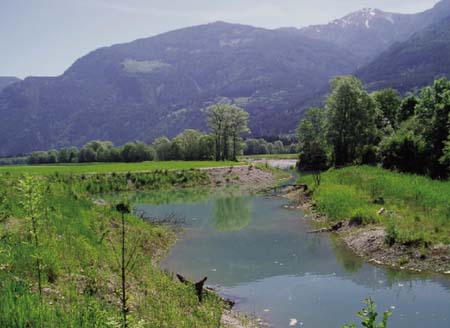 |
FAO FISHERIES TECHNICAL PAPER 484
Habitat rehabilitation for inland fisheries
Global review of effectiveness and guidance for rehabilitation of freshwater
ecosystems
by
Phil Roni, Karrie Hanson, Tim Beechie, George Pess, Michael Pollock
Watershed Program
Northwest Fisheries Science Center
National Oceanic and Atmospheric Administration
Seattle, United States of America
and
Devin M. Bartley
Inland Water Resources and Aquaculture Service
Fisheries Resources Division
FAO Fisheries Department
Rome, Italy
|
|
FOOD AND AGRICULTURE ORGANIZATION OF THE UNITED NATIONS
Rome, 2005
|
| |
Table of Contents
|
Cover photos:

Excavation of new off-channel habitat (River Drau,
Austria)

Lake habitat enhancement in North America

Planting of riparian trees (River Drau, Austria) (Courtesy
of Tennessee Wildlife Resources Agency)
The designations employed and the presentation of material in
this information product do not imply the expression of any opinion whatsoever
on the part of the Food and Agriculture Organization of the United Nations
concerning the legal or development status of any country, territory, city or
area or of its authorities, or concerning the delimitation of its frontiers or
boundaries.
ISBN 92-5-105354-5
ISSN 0429-9345
All rights reserved. Reproduction and dissemination of
material in this information product for educational or other non-commercial
purposes are authorized without any prior written permission from the copyright
holders provided the source is fully acknowledged. Reproduction of material in
this information product for resale or other commercial purposes is prohibited
without written permission of the copyright holders.
Applications for such permission should be addressed
to:
Chief
Publishing Management Service
Information
Division
FAO Viale delle Terme di Caracalla, 00100 Rome, Italy
or by
e-mail to:
[email protected]
© FAO 2005
Contents
Preparation of this document
Abstract
Acronyms and abbreviations
1. Introduction
1.1 Habitat restoration vs.
rehabilitation
1.2 Ecological basis for
rehabilitation
2. Effectiveness of common
techniques
2.1 Road rehabilitation
2.1.1 Techniques for reducing road
impacts
2.1.2 Effectiveness of techniques for
reducing road impacts
2.1.3 Conclusions - techniques for
reducing road impacts
2.2 Riparian
rehabilitation
2.2.1 Techniques for riparian
rehabilitation
2.2.1.1 Riparian silviculture
2.2.1.2 Fencing and grazing reduction
2.2.2 Effectiveness of riparian
rehabilitation
2.2.2.1 Effectiveness of riparian silviculture
2.2.2.2 Effectiveness of fencing and grazing
reduction
2.2.3 Conclusions - riparian
silviculture and fencing and grazing reduction
2.3 Floodplain rehabilitation
2.3.1 Overview of floodplain techniques
2.3.1.1 Connecting isolated habitats
2.3.1.2 Levee breeching and setbacks
2.3.1.3 Channel reconstruction or meandering
2.3.1.4 Construction of new floodplain
habitats
2.3.2 Effectiveness of floodplain rehabilitation
techniques
2.3.2.1 Isolated habitats
2.3.2.2 Levee breaching
2.3.2.3 Remeandering
2.3.2.4 Constructed habitats
2.3.3 Conclusions - floodplain habitats
2.4 Dam removal and flood restoration
2.4.1 Techniques for dam removal and flood
restoration
2.4.2 Effectiveness of dam removal and flood
restoration
2.4.2.1 Effectiveness dam removal
2.4.2.2 Effectiveness of flood restoration
2.4.3 Conclusions - dam removal and flood
restoration
2.5 Instream habitat structures
2.5.1 Common instream habitat structures
2.5.2 Effectiveness of instream structures
2.5.2.1 Physical habitat
2.5.2.2 Biological effectiveness of instream
structures
2.5.3 Conclusions - instream habitat structures
2.6 Lake habitat enhancement
2.6.1 Common lake habitat enhancement techniques
2.6.2 Effectiveness of lake habitat enhancement
2.6.3 Conclusions - lake habitat enhancement
2.7 Nutrient enrichment
2.7.1 Nutrient enrichment techniques
2.7.2 Effectiveness of nutrient enrichment
2.7.3 Conclusions - nutrient enrichment
2.8 Miscellaneous habitat rehabilitation methods
2.8.1 Beaver reintroduction or removal
2.8.2 Bank protection (riprap and bioengineering)
2.8.3 Brush removal
2.8.4 Habitat protection
2.8.5 Conclusions - miscellaneous rehabilitation
techniques
3.
Cost-effectiveness
3.1 Review of cost-effectivenes of
habitat rehabilitation
3.2 Conclusions -
cost-effectiveness
4. Prioritizing rehabilitation
activities
4.1 Determining what to
rehabilitate
4.2 Prioritizing actions
4.3 Conclusions for
prioritization
5. Monitoring and
evaluation
5.1 Definition of monitoring and
evaluation
5.2 Steps for developing monitoring
programmes
5.3 Conclusions for monitoring and
evaluation
6. Overall
summary
References
Glossary
Back cover



